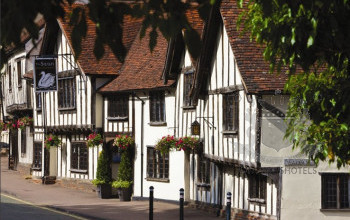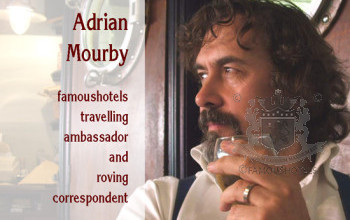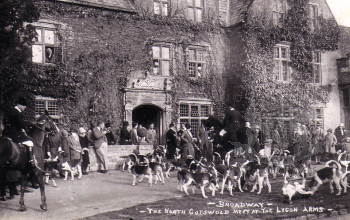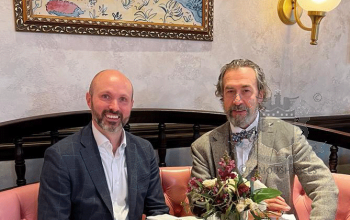Mourby of Harwich
( words)
He travels the world, visits the hospitality palaces of our globe, lives at luxurious hotels, surrounded by famous names of legendary travelers.
And then, Adrian Mourby came to stay at
THE PIER HOTEL, HARWICH
The history of hotel can sometimes encapsulate the history of the town in which it is built. I was reminded of this recently when staying in one of the most remarkable corners of Britain; a small section of quayside in the Essex port of Harwich.
Harwich, facing across the English Channel towards Flanders, has a long maritime history. At the Three Cups Inn the estranged wife of King Edward II waited for her horses in 1326 after arriving back from France. Within the year “The She Wolf of France” had deposed the English king and put her son Edward III on the throne. The Plantaganets were always disposing of each other, but the pub is still there. Nearby, in Kings Head Street, lived Captain Christopher Jones who in 1620 took the Mayflower, an old Harwich ship, down to Southampton to pick up some religious dissidents (now known as the Pilgrim Fathers) who wanted passage to the New World. His house is still there too.
The famous English diarist Samuel Pepys was a regular in Harwich because he worked for the Admiralty, and between 1660 and 1826 the Royal Naval Dockyard here built nearly 60 men-of-war for the British Navy. All these events – and more - took place on a small peninsula of land that pushes out into the Stour estuary. What put Harwich on the hotel map, however, was the arrival of the Great Eastern Railway from London in 1854. Suddenly it was possible to get on a train at London’s Liverpool Street Station and within 14 hours be in Rotterdam or Zeebrugge thanks to a fleet of ferries run by the same railway company. For those who didn’t manage the train/ferry connection immediately two hotels quickly sprang up. The first was the Pier, which was built on the site of a quayside brewery in 1860, and the second the Great Eastern Hotel, which opened in 1864 and was always considered far too big for the town.
The Great Eastern is still there, an imposing yellow brick building covered in Victorian statuary facing the quay, but it’s now converted into flats after a brief spell as Harwich’s town hall. By contrast the Pier next door is still a hotel, and a quite charming one at that.
The two buildings are odd companions. The Great Eastern could be plonked down quite comfortably next to Liverpool Street Station in London. It has the all imperial “belle époque” swagger of a Victorian hotel in the capital city with romanticised portraits of historical figures (including Pepys and Isabella of France) in ten roundels on its facade. The Pier by contrast is built in that dainty Italianate style that was popular in the early years of Victoria’s reign. It is a delicate neighbour, a Venetian palazzo in white stucco and blue paintwork with an octagonal lantern on its roof and just seven bedrooms. There used to be more but the first floor of the hotel has been turned into a glorious restaurant called The Harbourside that looks out across the estuary to Suffolk. It also looks out on to Ha’Penny Pier, which is one of those sweet little Victorian jetties where locals would promenade and go line-fishing. Both activities still take place today, but you no longer have to pay a ha’penny (£0.002) to gain access.
The Pier Hotel didn’t always look this good. When it opened in 1860 it was asymmetrical with only one wing to the side of its main entrance and no lantern. It took until 1869 – and some extra investment - for the matching wing and the lantern to be added. Then large letters were painted across the full width of the façade, proclaiming this as a "Family & Commercial Hotel". In the 1870s The Pier was also registered as an alehouse with a Mr John Brice as licencee. From 1910 to 1954 it was owned by the Daniell Company who ran a number of pubs in the Harwich area.
By 1978 when the entrepreneur Gerald Milsom purchased The Pier from Truman’s Brewery it was in need of some love and attention. Mr Milsom wanted to create a great harbourisde venue for seafood dining of the kind he had recently visited in New England. He also bought the Angel Inn, a low Dickensian pub from 1824, next door. This was converted into a rather quaint seven-bedroomed annex to the Pier with one of the loveliest maritime bedrooms I have stayed in. The Angel annex also has a remarkable view of the red and white Trinity House lightship that was featured in Richard Curtis’ film The Boat That Rocked. After impersonating a pirate radio ship in the movies, it’s now permanently moored in front of the Pier and Angel, close to the old Royal Naval Dockyard. Harwich has a way of collecting history and it all centres around this small section of quay with The Pier as the jewel in its maritime crown.
One reason it is all so beautifully preserved is that even before the end of the nineteenth century Harwich began constructing a new deep freight terminal at Parkeston meaning that the old quayside and pier did not have to be demolished in the name of progress.
But when the railways stopped running to the Harwich quayside after World War II, the Pier Hotel and the Great Eastern lost their raison d’etre. The Ha’penny Pier also lost something of its raison d’etre, ceasing to be the site of transfer from the boat train to the ferry. It had already lost half its length in a fire in 1927. But the Pier Hotel has survived and nowadays this busy East Anglian town – a port so strategic that you had to have a military pass even to live here during World War I - is a focal point for tourism. It is also a superb place for seafood with excellent local lobster and large heavy oysters from nearby Mersea Island. And the best place of all to eat them is in the Harbourside Restaurant. In this respect Mr Milsom’s New England vision has certainly paid off.
Harwich is a surprisingly lovely place to wander with more than its fair share of historic buildings but if it weren’t for the Pier Hotel I don’t think it would get as many visitors as it does today. The history of a hotel is often the history of famous people who have passed through its doors. No literary greats ever stayed at The Pier, not even Charles Dickens who slept in most British hotels. But the history of a hotel can also be the the history of the place in which it’s built. This hotel sprang up in Harwich because of the railways and the ferry. The ferry and the railways went and now tourists come for the hotel.











